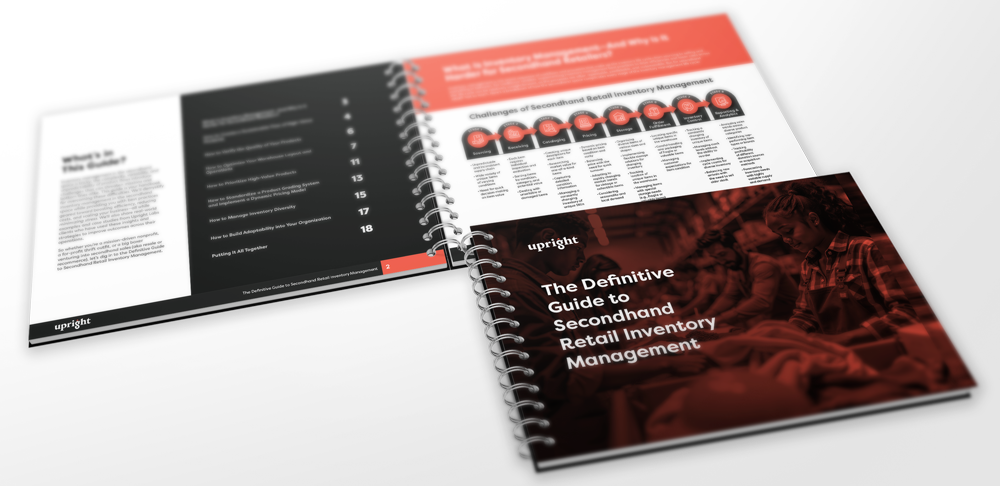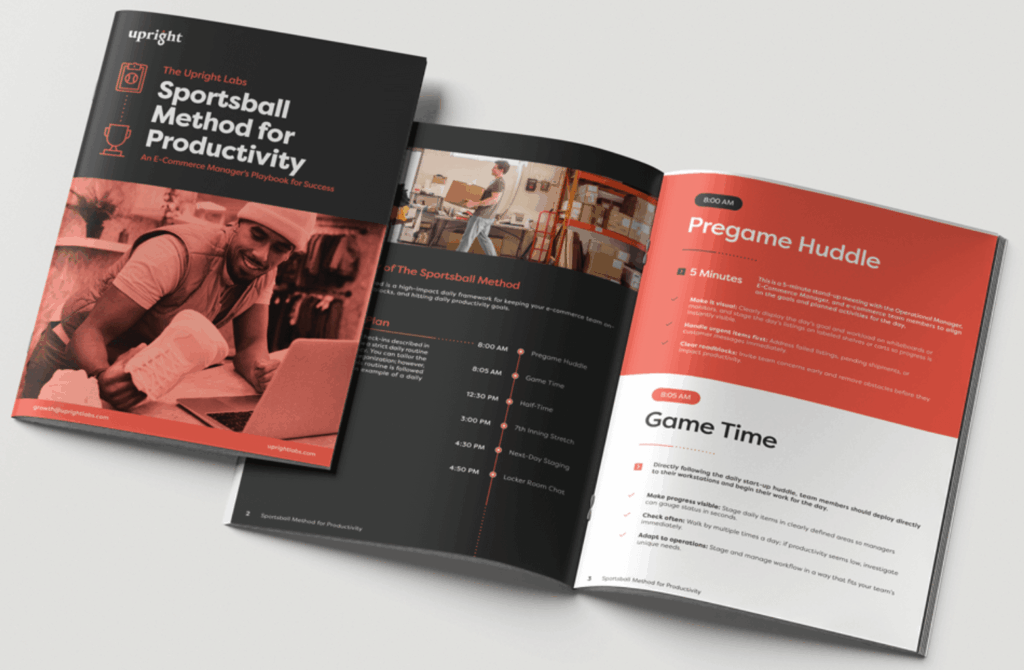Your customers may never see your warehouse, but they feel its workflows when an order arrives on time and as described. Mastering inventory management is essential to delivering that experience.
From receiving a donation to shipping an order, every step affects your efficiency, accuracy, and bottom line. Poor inventory management leads to lost items, late orders, and disappointed customers. Strong inventory processes move products faster, reduce errors, and keep customers coming back.
With 20 years of e-commerce experience and thousands of retail stores served, Upright Labs knows the challenges of secondhand. Constantly changing SKUs, unpredictable product flow, and items in every possible condition make it easy for warehouses to get overwhelmed. Upright Lister is built for this complexity, giving you the tools to track, organize, and optimize your inventory with ease.
Here are three proven tips to transform your inventory management, and how Upright Lister automates and supports each one:

The Definitive Guide to Secondhand Retail Inventory Management
Download our free 18-page guide full of actionable strategies to streamline operations, cut costs, and grow your business.
1. Organize for Speed and Accuracy
Why it Matters: Setting up a warehouse that supports your workflow is the foundation of successful inventory management. In secondhand retail, your product flow is diverse and every SKU is one-of-a-kind. Without a clear storage system, your team can lose valuable time searching for items and increase the risk of picking errors and shipping delays.
Best Practices:
- Standardize Your Storage Units: Modular shelving, numbered bins, and consistent labeling make your space clear and simple for everyone. When every storage unit follows the same format, new staff can get up to speed quickly and experienced pickers can move through the warehouse with ease.
- Use Location Sequencing: Label in logical order so pickers move in one direction, reducing unnecessary steps. This not only speeds up fulfillment but also helps ensure that inventory flows smoothly through each stage of its lifecycle without backtracking or bottlenecks.
- Barcode Everything: From products to shelf locations, barcodes eliminate guesswork and reduce human error. A clear, scannable label allows staff to instantly confirm an item’s identity and location, keeping orders accurate and inventory organized.
How Upright Lister Helps:
- Unique SKU Assignment: Automatically assigns a unique SKU to every item, even if similar products exist. This precise identification prevents confusion and ensures each product is tracked accurately throughout its lifecycle.
- Barcode Scanner Integration: Instantly locate inventory with barcode scanners. This seamless connection speeds up warehouse operations and keeps inventory data updated in real time.
- Inventory Locations: Define, update, and sync physical storage locations within Lister. You can mirror your digital inventory layout to your warehouse setup so your team always puts items exactly where they belong.
With Upright Lister handling all the details, your team can spend less time on tedious manual tasks and more time growing your business. Your daily operations can be easier, faster, and far less stressful.
💡 Real-World Impact: Goodwill Industries of Northern Illinois doubled their listings in under 6 months and increased their revenue by 64% after integrating Upright Lister and executing a warehouse redesign.

2. Complete Regular Audits and Purge
Why it Matters: Out-of-date inventory data leads to overselling, customer frustration, wasted warehouse space, and “Can’t Finds” which force clients to cancel orders. Regular audits keep your listings accurate, and purging dead stock makes room for items that actually sell. Maintaining lean, efficient, and accurate operations builds a trustworthy store that customers return to again and again.
Best Practices:
- Audits: Perform inventory audits weekly, or daily if possible, to keep listings accurate. Create a schedule that cycles through your entire inventory within a month, breaking the process into manageable sections so errors are caught early and costly problems are avoided.
- Purge Dead Inventory: Set a time limit for unsold items, then re-donate, recycle, or bundle them for clearance. Removing dead inventory frees up valuable storage space for fresh, high-demand products that turn over more quickly.
- Use a Checklist: Create a simple, repeatable checklist that guides staff through each step of the process. Even on the busiest days, it ensures your team catches every detail and avoids costly oversights.

Get The Sportsball Method for Productivity!
A daily framework built for resale leaders and e-commerce managers who want more visibility, accountability, and output from their teams.
How Upright Lister Helps:
- Track Inventory Age: Automatically records how long each item has been in stock, making it easy to spot products ready for purging. Eliminates the guesswork and decisions are based on real data.
- Flag Stale Listings: Quickly identifies inactive or slow-moving items for removal, relisting, or bulk sale to maximize warehouse space and profitability.
- Audit Reports: Generate fast, accurate reports comparing physical stock to online listings, saving hours of manual counting and keeping your data up to date.
Upright Lister’s audit and purging tools keep your inventory accurate and fresh. Your team can confidently avoid overselling, free up warehouse space, and focus on products that move.
💡 Real-World Impact: Goodwill of Greater Washington leveraged Upright Lister’s reporting tools to strategically reduce its inventory backlog by selling similar items in bulk. This freed up space for new inventory and allowed the team to prioritize best-selling categories with strong sell-through rates.

3. Let Data Drive Your Decisions
Why it Matters: Without visibility into what’s selling (and what’s not), you’re making sourcing, pricing, and storage decisions in the dark. Data helps you prioritize high-value products, spot trends, and allocate resources where they’ll have the most impact.
Best Practices:
- Track Sales Velocity: Identify fast sellers and prioritize them in processing and storage. Focusing on these products/brands helps reduce holding time and increases your sales.
- Analyze by Source: Know which donors, vendors, or categories deliver the best ROI. Leverage this knowledge and build stronger partnerships to optimize your sourcing strategies.
- Adjust Pricing Dynamically: Use grading systems and market trends to keep prices competitive. Regular adjustments ensure you maximize profits while staying attractive to buyers.
How Upright Lister Helps:
- Real-Time Sales Insights: See best-sellers and slow movers by category, brand, and supplier. Use this data for smarter sourcing, pricing, and purging decisions.
- Donor Performance: Tie outcomes to donors and vendors to pinpoint which sourcing channels drive ROI. Supports supplier negotiations and inventory planning.
- Item Preferences: Set clear accept and reject lists so suppliers know exactly what to send, refining your inventory to match demand while reducing excess stock.
Lister’s real-time sales and sourcing insights empower your team to make smarter, faster decisions. Prioritize what sells, optimize pricing, and build stronger supplier relationships to maximize profits.
💡 Real-World Impact: Salvation Army Eastern began their e-commerce journey with Upright Labs’ guidance, learning best practices to set up efficient workflows, optimize product flow, and make data-informed decisions. They more than tripled their goals, reaching over $30,000 in sales in one month.

Upright Lister is Built for Secondhand
Most inventory systems are designed for traditional retail, where stock is predictable and repeatable. Every item is unique in secondhand and supply is inconsistent, so your warehouse needs to adapt daily.
Upright Lister was built with these challenges in mind, offering:
- Multi-Channel Integration: List once and sell on eBay, Shopify, ShopGoodwill, and more.
- Customizable Listing Workflows: Automated pricing and relisting features.
- Bulk Editing: Update hundreds of listings at once.
- Detailed Inventory Dashboards: Export data and receive alerts for bottlenecks and growth opportunities.
- Supplier Tracking and Quality Control Tools: Keep detailed records of donors and vendors, and set inventory standards with built-in quality checks.
We engineered Upright Lister to tackle the complexities of secondhand e-commerce by automating key daily inventory tasks. Spend less time on busywork and more time growing your business with confidence.
Ready to Kickstart Your Growth?
With better inventory management, you’re unlocking faster listings, smoother workflows, fewer errors, and more sales.
📘 Download Our Free E-Book, The Definitive Guide to Secondhand Retail Inventory Management, for even more strategies and best practices.
👉 Book a Personalized Demo of Upright Lister and see how we can support your secondhand operations.


